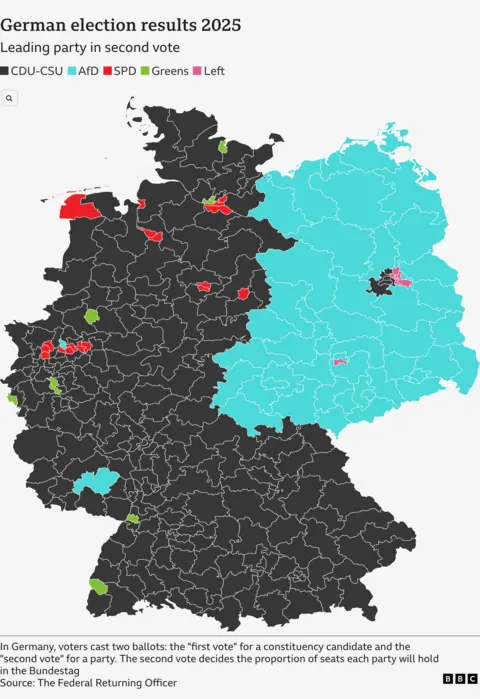Europe digital editor in Berlin

 Getty Images
Getty ImagesFriedrich Merz’s conservatives have won, but Germany’s 2025 election has thrown up some important and fascinating stories that reveal a country in flux.
Alternative for Germany, or AfD, has doubled its support in just four years to 20.8%, and has spread out from its support base in the east to become the second biggest political force in parliament.
Meanwhile, outgoing Chancellor Olaf Scholz’s SPD had its worst performance in decades, only sharing 16.4% of the vote.
Here are five key takeaways.
AfD dominant in east, spreading to the west
Look at an election results map of Germany, and you could almost have travelled back in time to the Cold War, when an iron curtain divided communist East Germany from the west.
In the east it’s a swathe of AfD light blue, apart from pockets like Berlin and half of Leipzig. In the west the vast majority has turned conservative black, especially in Bavaria where Merz’s conservative sister party, the CSU, dominates the landscape.
But the AfD is spreading in the west too, and political loyalty to the old mainstream parties has gone.
Its main message is “remigration”, which it defines as deporting migrants who have committed crimes. But the term can also refer to the mass deportation of migrants and their descendants.
The AfD wants a vote on leaving the EU if it can’t reform it, to scrap climate change measures, build nuclear power plants, and repair gas lines and relations with Russia.
For one in five Germans it has become normalised. “They’re just normal people,” said one young man of immigrant origin in Duisburg, a city in western Germany’s old industrial heartland.


Even though it came second, the AfD is blocked from being part of the next government because of a “firewall” – or Brandmauer – operated by Germany’s main parties, who do not co-operate with any party seen as extremist since the end of World War Two.
The AfD’s leader Alice Weidel insists it is a libertarian, conservative movement, not racist. Its big increase in public support has coincided with a series of deadly attacks in the past nine months, all allegedly by immigrants.
The AfD has embraced a highly controversial policy called “remigration”, which it defines as deporting migrants who have committed crimes. But the term can also refer to the mass deportation of migrants and their descendants.
However, in May 2024 a German court rejected an AfD appeal against a ruling classifying it as a suspected far-right extremist organisation. Judges found that the AfD had “positions that disparage the democratic order and are incompatible with the principle of democracy”.
In three German states in the east – Thuringia, Saxony-Anhalt and Saxony – domestic intelligence has designated the AfD as right-wing extremist.
A leading AfD figure in Thuringia, Björn Höcke, has twice been convicted of using a banned Nazi slogan “Alles für Deutschland” – everything for Germany. Alice Weidel supporters have chanted her name during the election campaign, using the phrase “Alice für Deutschland”.
Germans voted in biggest turnout for 40 years
Not since 1987 has turnout been as high as 82.5% in a German election, and that was three years before reunification of east and west.
Four years ago it was 76.6%.
Put simply, more than four in every five of Germany’s 59.2 million voters turned out.
It reflects just how energised Germans have been by this election, which comes at a pivotal moment for their country. There were nine TV debates in the final stretch of the campaign, but that reflected the broad interest of the audience.
All over for leaders of collapsed government
The three-party government of outgoing Chancellor Olaf Scholz fell apart at the end of last year, and within 24 hours of Sunday’s election, all three leaders have said they’re leaving the front line of politics.
The leader of the economic liberals, the FDP, was first. Christian Lindner has led his party for 11 years. But it failed to get any MPs elected and Lindner has said he’s leaving politics after 25 years.
It was Lindner’s refusal to compromise on debt rules that first brought the government down, and then sent his party into the wilderness.
Although Scholz will remain as chancellor until the next government is formed, he won’t be taking part in coalition talks and will be leaving frontline politics.
Greens Vice-Chancellor Robert Habeck is also leaving frontline politics after his party fell below 12% in the election.
TikTok generation hauls Left back from dead
Until a few weeks ago, the Left party looked doomed when one of its leading lights, Sahra Wagenknecht, went off and founded her own, more populist, party with eight other MPs.
Wagenknecht’s popularity soared for a while as head of her BSW party, but ultimately fell just below the 5% threshold for getting into parliament.
The story was very different for the Left (Die Linke), which came back from the dead with an inspired social medial campaign.
Heidi Reichinnek, Die Linke’s co-chair, went viral after she gave a speech enthusiastically defending the firewall against the AfD. She now has 580,000 followers on TikTok and her post has attracted seven million views.
Her party secured just under 9% of the vote.
Young go left and right, old stick to centre
Die Linke’s viral videos helped secure a quarter of the 18-24 vote, and the AfD were not far behind with 21%, according to surveys by ARD TV.
Alice Weidel was the biggest hit on social media during the election, even bigger than Heidi Reichinnek. She has attracted more than 935,000 followers on TikTok.
For the over-35s, it was the Christian Democrats who won out, and more men than women.
Article by:Source:














